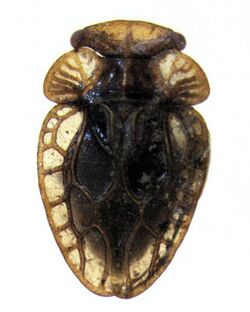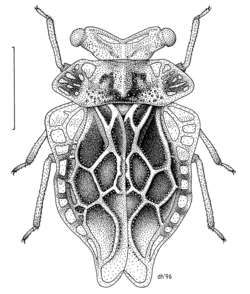Biology:Peloridiidae
| Peloridiidae | |
|---|---|

| |
| Xenophyes rhachilophus | |

| |
| Xenophyes forsteri | |
| Scientific classification | |
| Domain: | Eukaryota |
| Kingdom: | Animalia |
| Phylum: | Arthropoda |
| Class: | Insecta |
| Order: | Hemiptera |
| Suborder: | Coleorrhyncha |
| Superfamily: | Peloridioidea |
| Family: | Peloridiidae Breddin, 1897 |
The Peloridiidae or moss bugs are a family of true bugs, comprising eighteen genera and thirty-four species. They are small, ranging in length from 2 to 4 mm, rarely seen, peculiarly lumpy, flattened bugs found in Patagonia (Argentina and Chile ), New Zealand, eastern Australia , Lord Howe Island, and New Caledonia. Peloridiids are found amongst mosses and liverworts, commonly in association with southern beech forests. They have become known as moss bugs for their habit of feeding on mosses. Almost all Peloridiidae species are flightless, except one (Peloridium hammoniorum).[lower-alpha 1] Their present distribution suggests they have existed since before the breakup of Gondwana. They are the only living members of the suborder Coleorrhyncha, which first appeared in the Upper Permian, over 250 million years ago.
Evolution
Peloridiidae are the only extant[lower-alpha 2] family in the suborder Coleorrhyncha. Historically the Peloridiidae and their fossil kin were assigned to a variety of orders. In 1929 they were placed in the Homoptera,[3] in 1962 they were placed in the Auchenorrhyncha,[4] in 1963 they were placed in the Cicadomorpha,[5] and in 1997 they were placed in Fulgoromorpha.[6] However, essentially all sources since 1969 are in consensus that the Peloridiidae belong in Coleorrhyncha and that Coleorrhyncha is a sister group to the Heteroptera.[7][8][9][10][11][12][13]
The question remains whether this affinity between the Coleorrhyncha and the Heteroptera necessitates the imposition of a suborder between them and the order Hemiptera. In 1995 Sorensen proposed the name Prosorrhyncha for such a suborder.[14] (See the Heteroptera and Prosorrhyncha pages for a discussion).
The oldest members of Coleorrhyncha are known from the Upper Permian, over 250 million years ago, assigned to the family Progonocimicidae. It is likely that Progonocimicidae is paraphyletic, with other families of Coleorrhyncha derived from it. The closest relatives of Peloridiidae are the Hoploridiidae from the Early Cretaceous of Asia.[15]
Genera
- Craspedophysa Burckhardt, 2009
- Hackeriella Evans, 1972
- Hemiodoecellus Evans, 1959
- Hemiodoecus China, 1924
- Hemiowoodwardia Evans, 1972
- Howeria Evans, 1959
- Idophysa Burckhardt, 2009
- Kuscheloides Evans, 1982
- Oiophysa Drake & Salmon, 1950
- Oiophysella Evans, 1982
- Pantinia China, 1962
- Peloridium Breddin, 1897
- Peloridora China, 1955
- Peltophysa Burckhardt, 2009
- Rhacophysa Burckhardt, 2009
- Xenophyes Bergroth, 1924
- Xenophysella Evans, 1982
Notes
- ↑ The South American Peloridiidae Peloridium hammoniorum Breddin, 1897 has both a winged and a wingless form.[1]
- ↑ Other families in the Coleorrhyncha are preserved in the fossil record, notably the early Progonocimicidae, and the later Karabasiidae and Hoploridiidae.[2]
References
- ↑ Burckhardt, Daniel (2009). "Taxonomy and phylogeny of the Gondwanan moss bugs or Peloridiidae (Hemiptera, Coleorrhyncha)". Deutsche Entomologische Zeitschrift 56 (2): 173–235. doi:10.1002/mmnd.200900019.
- ↑ Heads, Sam W. (2008). "A new species of Yuripopovia (Coleorrhyncha: Progonocimicidae) from the Early Cretaceous of the Isle of Wight". British Journal of Entomology and Natural History 21: 247–253. http://fossilinsects.net/pdfs/Heads_2008_BJENH_YuripopoviaEarlyCretIsleOfWight.pdf.
- ↑ Myers, John Golding; China, William Edward (1929). "The systematic position of the Peloridiidae as elucidated by a further study of the external anatomy of Hemiodoecus leadi China". Annals and Magazine of Natural History 105 (3): 282–294. doi:10.1080/00222932908672971.
- ↑ China, William Edward (1962). "South American Peloridiidae (Hemiptera–Homoptera: Coleorrhyncha)". Transactions of the Royal Entomological Society of London 114 (5): 131–161. doi:10.1111/j.1365-2311.1962.tb01077.x.
- ↑ Evans, John William (1963). "The systematic position of the Ipsviciidae (Upper Triassic Hemiptera) and some new Upper Permian and Middle Triassic Hemiptera from Australia (Insecta)". Australian Journal of Entomology 2 (1): 17–23. doi:10.1111/j.1440-6055.1963.tb00384.x.
- ↑ Bourgoin, Thierry H.; Steffen‐Campbell, J. D.; Campbell, B. C. (1997). "Molecular phylogeny of Fulgoromorpha (Insecta, Hemiptera, Archaeorrhyncha). The enigmatic Tettigometridae: evolutionary affiliations and historical biogeography". Cladistics 13 (3): 207–224. doi:10.1111/j.1096-0031.1997.tb00316.x. PMID 34911231. https://www.researchgate.net/publication/227783479.
- ↑ Schlee, Dieter (1969). "Morphologie und Symbiose, ihre Beweiskraft für die Verwandtschaftsbeziehungen der Coleorrhyncha (Insecta, Hemiptera): phylogenetische Studien an Hemiptera IV: Heteropteroidea (Heteroptera+ Coleorrhyncha) als monophyletische Gruppe" (in German). Staatliches Museum für Naturkunde 210: 1–27.
- ↑ Popov, Yu A.; Wootton, Robin J. (1977). "The Upper Liassic Heteroptera of Mecklenburg and Saxony". Systematic Entomology 2 (4): 333–351. doi:10.1111/j.1365-3113.1977.tb00382.x.
- ↑ Wheeler, Ward C.; Schuh, Randall T.; Bang, Ranhy (1993). "Cladistic relationships among higher groups of Heteroptera: congruence between morphological and molecular data sets". Insect Systematics & Evolution 24 (2): 121–137. doi:10.1163/187631293X00235.
- ↑ Campbell, Bruce C.; Steffen-Campbell, Jody D.; Sorensen, John T.; Gill, Raymond J. (1995). "Paraphyly of Homoptera and Auchenorrhyncha inferred from 18S rDNA nucleotide sequences". Systematic Entomology 20 (3): 175―194. doi:10.1111/j.1365-3113.1995.tb00090.x.
- ↑ Schuh, Randall T.; Slater, James Alexander (1995). True bugs of the world (Hemiptera: Heteroptera): classification and natural history. Ithaca, New York: Cornell University Press. ISBN 978-0-8014-2066-5.
- ↑ Ouvrard, David; Campbell, Bruce C.; Bourgoin, Thierry; Chan, Kathleen L. (2000). "18S rRNA Secondary Structure and Phylogenetic Position of Peloridiidae (Insecta, Hemiptera)". Molecular Phylogenetics and Evolution 16 (3): 403–417. doi:10.1006/mpev.2000.0797. PMID 10991793.
- ↑ Brozç, Jolanta (2007), Labial sensillae and the internal structure of the mouthparts of Xenophyes cascus (Bergroth 1924)(Peloridiidae: Coleorrhyncha: Hemiptera) and their significance in evolutionary studies on the Hemiptera, http://jaf.student.kul.lublin.pl/files/323/03brozek.pdf
- ↑ Sorensen, John T.; Campbell, Bruce C.; Gill, Raymond J.; Steffen-Campbell, Jody D. (1995). "Non-monophyly of Auchenorrhyncha ("Homoptera"), based upon 18S rDNA phylogeny: eco-evolutionary and cladistic implications within pre-Heteropterodea Hemiptera (sl) and a proposal for new monophyletic suborders". The Pan-Pacific Entomologist 71 (1): 31–60.
- ↑ Jiang, Tian; Wang, Bo; Szwedo, Jacek (January 2019). "The first representative of Progonocimicidae (Hemiptera: Coleorrhyncha) from mid-Cretaceous Burmese amber" (in en). Cretaceous Research 93: 346–359. doi:10.1016/j.cretres.2018.09.018. https://linkinghub.elsevier.com/retrieve/pii/S0195667118301812.
Other reading
- Bergroth, Ernst Evald (1924). "A new genus of Peloridiidae from New Zealand". Entomologist's Monthly Magazine 60: 178–181.
- Burckhardt, Daniel (2010). "Mooswanzen–Peloridiidae (Hemiptera, Coleorrhyncha), eine enigmatische Insektengruppe" (in German). Entomologica Austriaca 17: 9–22. Archived from the original on 20 December 2013. https://web.archive.org/web/20131220215504/http://www.landesmuseum.at/pdf_frei_remote/ENTAU_0017_0001-0022.pdf. Retrieved 20 December 2013.
- Evans, John William (1982). "A review of present knowledge of the family Peloridiidae and new genera and new species from New Zealand and New Caledonia (Hemiptera: Insecta)". Records of the Australian Museum 34 (5): 381–406. doi:10.3853/j.0067-1975.34.1982.296. Archived from the original on 5 December 2011. https://web.archive.org/web/20111205093159/http://australianmuseum.net.au/Uploads/Journals/17574/296_complete.pdf.
- Hoch, H.; Deckert, J.; Wessel, A. (2006). "Vibrational signalling in a Gondwanan relict insect (Hemiptera: Coleorrhyncha: Peloridiidae).". Biology Letters 2 (2): 222–224. doi:10.1098/rsbl.2006.0451. PMID 17148367. PMC 1618915. Archived from the original on 2012-12-23. https://archive.today/20121223043707/http://www.journals.royalsoc.ac.uk/content/vm751t338366x5p1/.
- Larivière, Marie-Claude; Burckhardt, Daniel; Larochelle, André (2011) (in English, Māori). Peloridiidae (Insecta: Hemiptera: Coleorrhyncha). Fauna of New Zealand, No. 67. Lincoln, Canterbury, New Zealand: Manaaki Whenua Press, Landcare Research. ISBN 978-0-478-34730-2. Abstract
- Kuechler, Stefan Martin (2013). "Diversity of bacterial endosymbionts and bacteria–host co‐evolution in Gondwanan relict moss bugs (Hemiptera: Coleorrhyncha: Peloridiidae)". Environmental Microbiology 15 (7): 2031–2042. doi:10.1111/1462-2920.12101. PMID 23452253.
External links
- Images of Peloridium hammoniorum http://homepage.ruhr-uni-bochum.de/Andre.Mursch/14.htm
Wikidata ☰ Q138276 entry
 |


